Law Case Study: Daubert v. Merrell Dow & Expert Witness Standards
VerifiedAdded on 2023/04/25
|6
|951
|128
Case Study
AI Summary
This case study delves into the Daubert v. Merrell Dow Pharmaceuticals case, focusing on the admissibility of expert witness testimony in federal courts. It contrasts the Daubert Standard with the older Frye Standard, highlighting the shift in determining the validity of scientific evidence. The analysis covers the Federal Rules of Evidence and their impact on judicial discretion in admitting expert testimony, referencing subsequent cases like Kumho Tire Co. v. Carmichael that expanded the Daubert principle. The study concludes that the Daubert Standard provides a more lenient yet scientifically grounded approach to assessing expert witness admissibility, emphasizing the importance of cross-examination and judicial oversight in ensuring fair legal proceedings. Desklib provides a platform for students to access similar solved assignments and past papers.
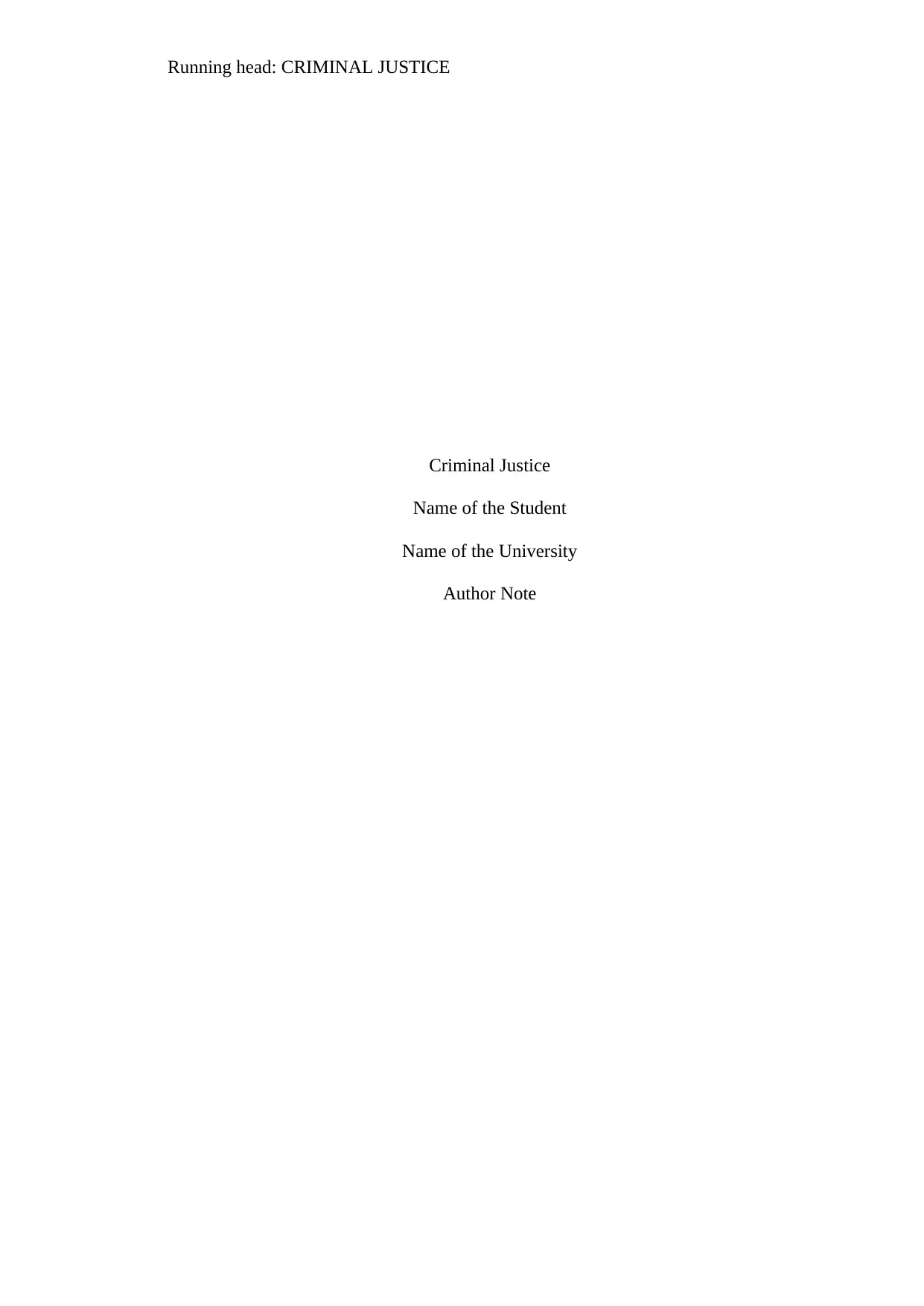
Running head: CRIMINAL JUSTICE
Criminal Justice
Name of the Student
Name of the University
Author Note
Criminal Justice
Name of the Student
Name of the University
Author Note
Paraphrase This Document
Need a fresh take? Get an instant paraphrase of this document with our AI Paraphraser
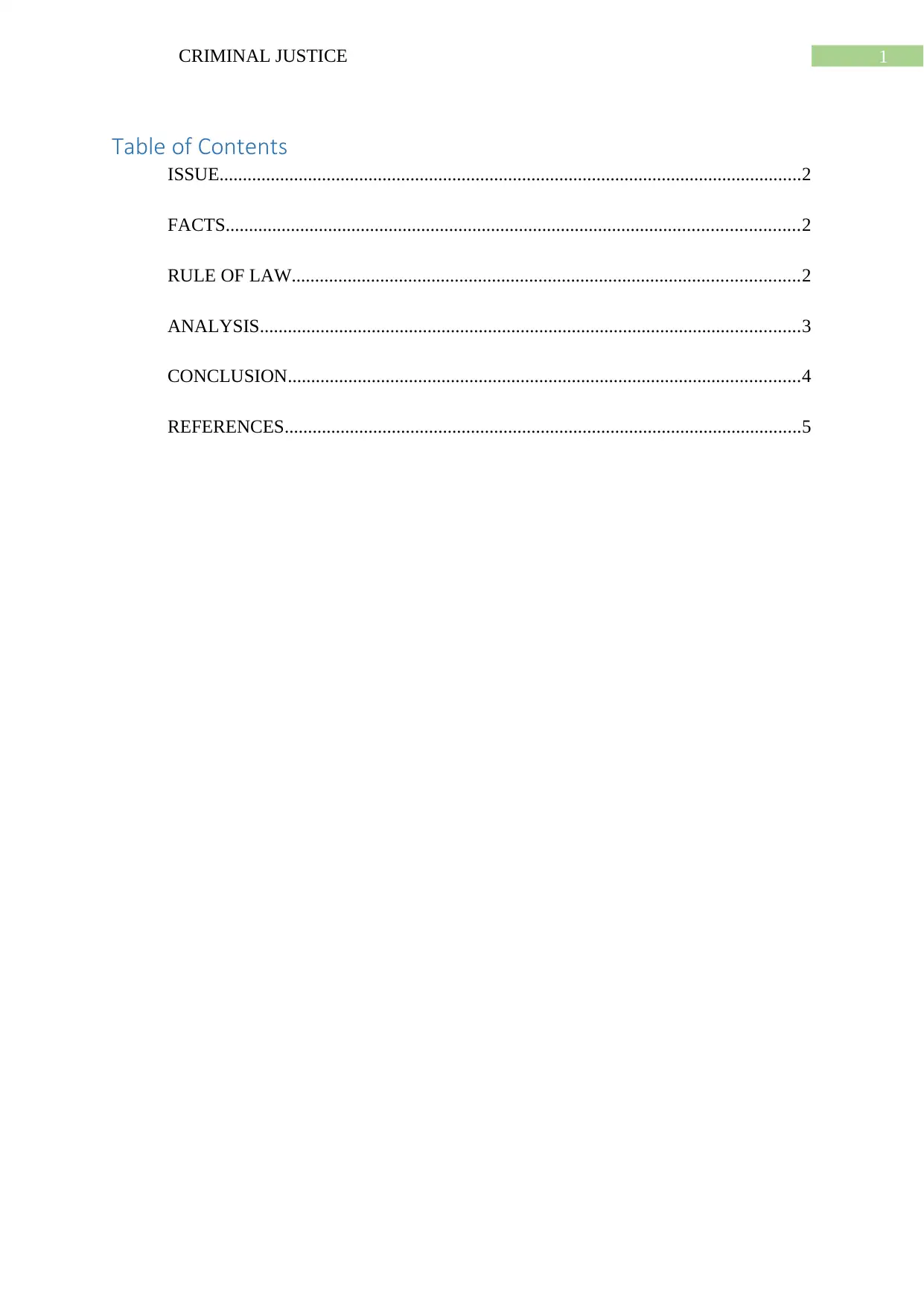
1CRIMINAL JUSTICE
Table of Contents
ISSUE.............................................................................................................................2
FACTS...........................................................................................................................2
RULE OF LAW.............................................................................................................2
ANALYSIS....................................................................................................................3
CONCLUSION..............................................................................................................4
REFERENCES...............................................................................................................5
Table of Contents
ISSUE.............................................................................................................................2
FACTS...........................................................................................................................2
RULE OF LAW.............................................................................................................2
ANALYSIS....................................................................................................................3
CONCLUSION..............................................................................................................4
REFERENCES...............................................................................................................5
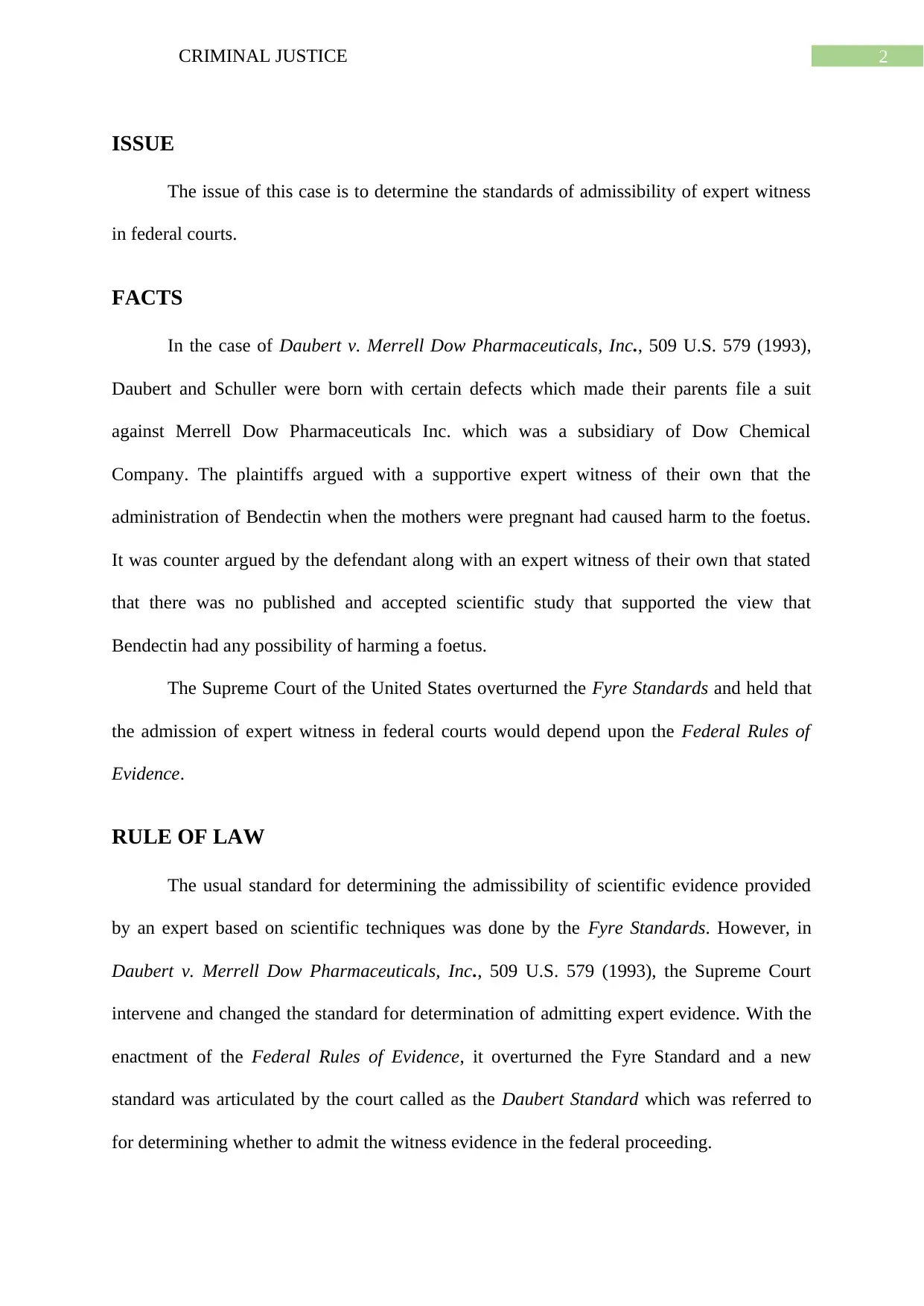
2CRIMINAL JUSTICE
ISSUE
The issue of this case is to determine the standards of admissibility of expert witness
in federal courts.
FACTS
In the case of Daubert v. Merrell Dow Pharmaceuticals, Inc., 509 U.S. 579 (1993),
Daubert and Schuller were born with certain defects which made their parents file a suit
against Merrell Dow Pharmaceuticals Inc. which was a subsidiary of Dow Chemical
Company. The plaintiffs argued with a supportive expert witness of their own that the
administration of Bendectin when the mothers were pregnant had caused harm to the foetus.
It was counter argued by the defendant along with an expert witness of their own that stated
that there was no published and accepted scientific study that supported the view that
Bendectin had any possibility of harming a foetus.
The Supreme Court of the United States overturned the Fyre Standards and held that
the admission of expert witness in federal courts would depend upon the Federal Rules of
Evidence.
RULE OF LAW
The usual standard for determining the admissibility of scientific evidence provided
by an expert based on scientific techniques was done by the Fyre Standards. However, in
Daubert v. Merrell Dow Pharmaceuticals, Inc., 509 U.S. 579 (1993), the Supreme Court
intervene and changed the standard for determination of admitting expert evidence. With the
enactment of the Federal Rules of Evidence, it overturned the Fyre Standard and a new
standard was articulated by the court called as the Daubert Standard which was referred to
for determining whether to admit the witness evidence in the federal proceeding.
ISSUE
The issue of this case is to determine the standards of admissibility of expert witness
in federal courts.
FACTS
In the case of Daubert v. Merrell Dow Pharmaceuticals, Inc., 509 U.S. 579 (1993),
Daubert and Schuller were born with certain defects which made their parents file a suit
against Merrell Dow Pharmaceuticals Inc. which was a subsidiary of Dow Chemical
Company. The plaintiffs argued with a supportive expert witness of their own that the
administration of Bendectin when the mothers were pregnant had caused harm to the foetus.
It was counter argued by the defendant along with an expert witness of their own that stated
that there was no published and accepted scientific study that supported the view that
Bendectin had any possibility of harming a foetus.
The Supreme Court of the United States overturned the Fyre Standards and held that
the admission of expert witness in federal courts would depend upon the Federal Rules of
Evidence.
RULE OF LAW
The usual standard for determining the admissibility of scientific evidence provided
by an expert based on scientific techniques was done by the Fyre Standards. However, in
Daubert v. Merrell Dow Pharmaceuticals, Inc., 509 U.S. 579 (1993), the Supreme Court
intervene and changed the standard for determination of admitting expert evidence. With the
enactment of the Federal Rules of Evidence, it overturned the Fyre Standard and a new
standard was articulated by the court called as the Daubert Standard which was referred to
for determining whether to admit the witness evidence in the federal proceeding.
⊘ This is a preview!⊘
Do you want full access?
Subscribe today to unlock all pages.

Trusted by 1+ million students worldwide
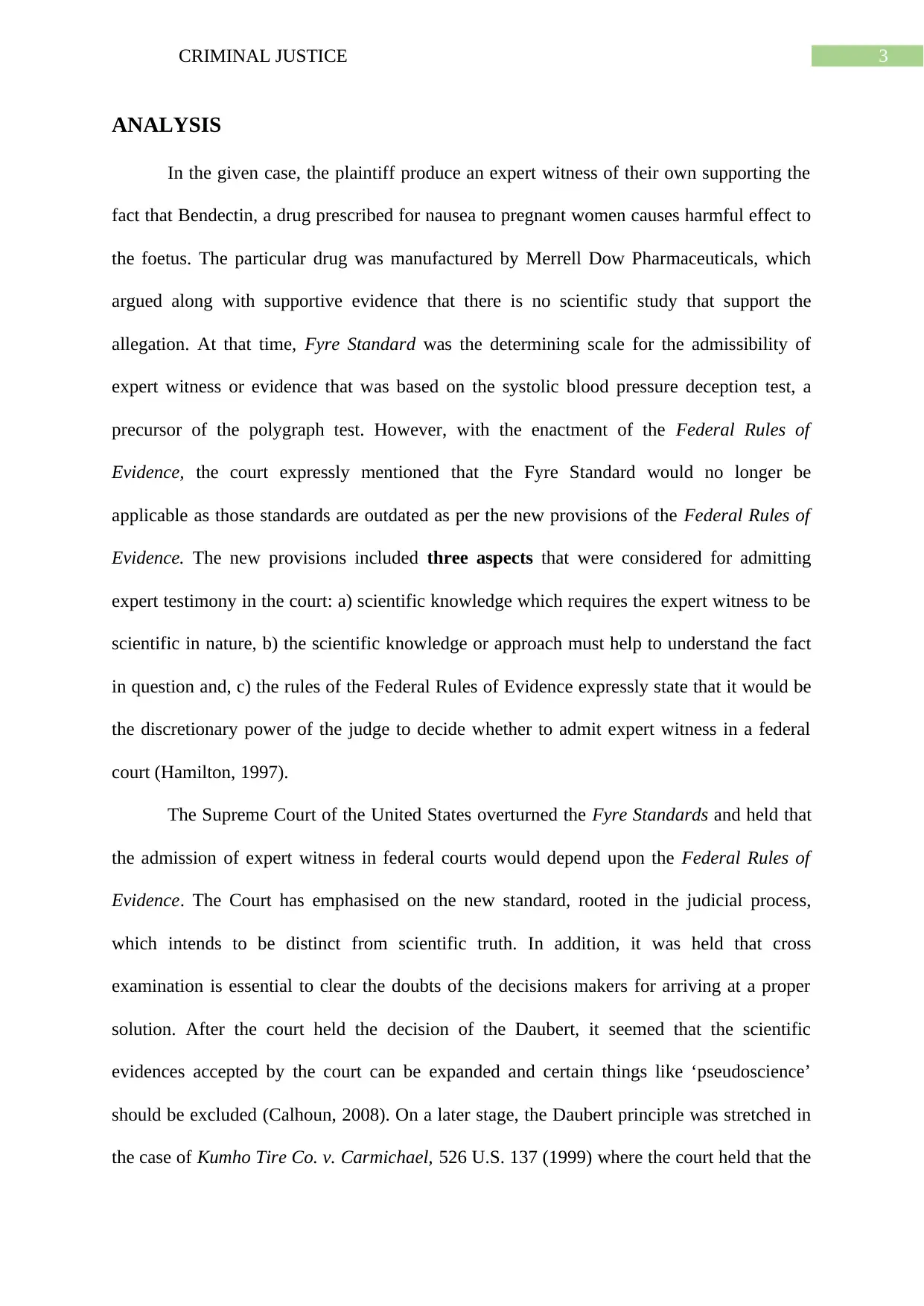
3CRIMINAL JUSTICE
ANALYSIS
In the given case, the plaintiff produce an expert witness of their own supporting the
fact that Bendectin, a drug prescribed for nausea to pregnant women causes harmful effect to
the foetus. The particular drug was manufactured by Merrell Dow Pharmaceuticals, which
argued along with supportive evidence that there is no scientific study that support the
allegation. At that time, Fyre Standard was the determining scale for the admissibility of
expert witness or evidence that was based on the systolic blood pressure deception test, a
precursor of the polygraph test. However, with the enactment of the Federal Rules of
Evidence, the court expressly mentioned that the Fyre Standard would no longer be
applicable as those standards are outdated as per the new provisions of the Federal Rules of
Evidence. The new provisions included three aspects that were considered for admitting
expert testimony in the court: a) scientific knowledge which requires the expert witness to be
scientific in nature, b) the scientific knowledge or approach must help to understand the fact
in question and, c) the rules of the Federal Rules of Evidence expressly state that it would be
the discretionary power of the judge to decide whether to admit expert witness in a federal
court (Hamilton, 1997).
The Supreme Court of the United States overturned the Fyre Standards and held that
the admission of expert witness in federal courts would depend upon the Federal Rules of
Evidence. The Court has emphasised on the new standard, rooted in the judicial process,
which intends to be distinct from scientific truth. In addition, it was held that cross
examination is essential to clear the doubts of the decisions makers for arriving at a proper
solution. After the court held the decision of the Daubert, it seemed that the scientific
evidences accepted by the court can be expanded and certain things like ‘pseudoscience’
should be excluded (Calhoun, 2008). On a later stage, the Daubert principle was stretched in
the case of Kumho Tire Co. v. Carmichael, 526 U.S. 137 (1999) where the court held that the
ANALYSIS
In the given case, the plaintiff produce an expert witness of their own supporting the
fact that Bendectin, a drug prescribed for nausea to pregnant women causes harmful effect to
the foetus. The particular drug was manufactured by Merrell Dow Pharmaceuticals, which
argued along with supportive evidence that there is no scientific study that support the
allegation. At that time, Fyre Standard was the determining scale for the admissibility of
expert witness or evidence that was based on the systolic blood pressure deception test, a
precursor of the polygraph test. However, with the enactment of the Federal Rules of
Evidence, the court expressly mentioned that the Fyre Standard would no longer be
applicable as those standards are outdated as per the new provisions of the Federal Rules of
Evidence. The new provisions included three aspects that were considered for admitting
expert testimony in the court: a) scientific knowledge which requires the expert witness to be
scientific in nature, b) the scientific knowledge or approach must help to understand the fact
in question and, c) the rules of the Federal Rules of Evidence expressly state that it would be
the discretionary power of the judge to decide whether to admit expert witness in a federal
court (Hamilton, 1997).
The Supreme Court of the United States overturned the Fyre Standards and held that
the admission of expert witness in federal courts would depend upon the Federal Rules of
Evidence. The Court has emphasised on the new standard, rooted in the judicial process,
which intends to be distinct from scientific truth. In addition, it was held that cross
examination is essential to clear the doubts of the decisions makers for arriving at a proper
solution. After the court held the decision of the Daubert, it seemed that the scientific
evidences accepted by the court can be expanded and certain things like ‘pseudoscience’
should be excluded (Calhoun, 2008). On a later stage, the Daubert principle was stretched in
the case of Kumho Tire Co. v. Carmichael, 526 U.S. 137 (1999) where the court held that the
Paraphrase This Document
Need a fresh take? Get an instant paraphrase of this document with our AI Paraphraser
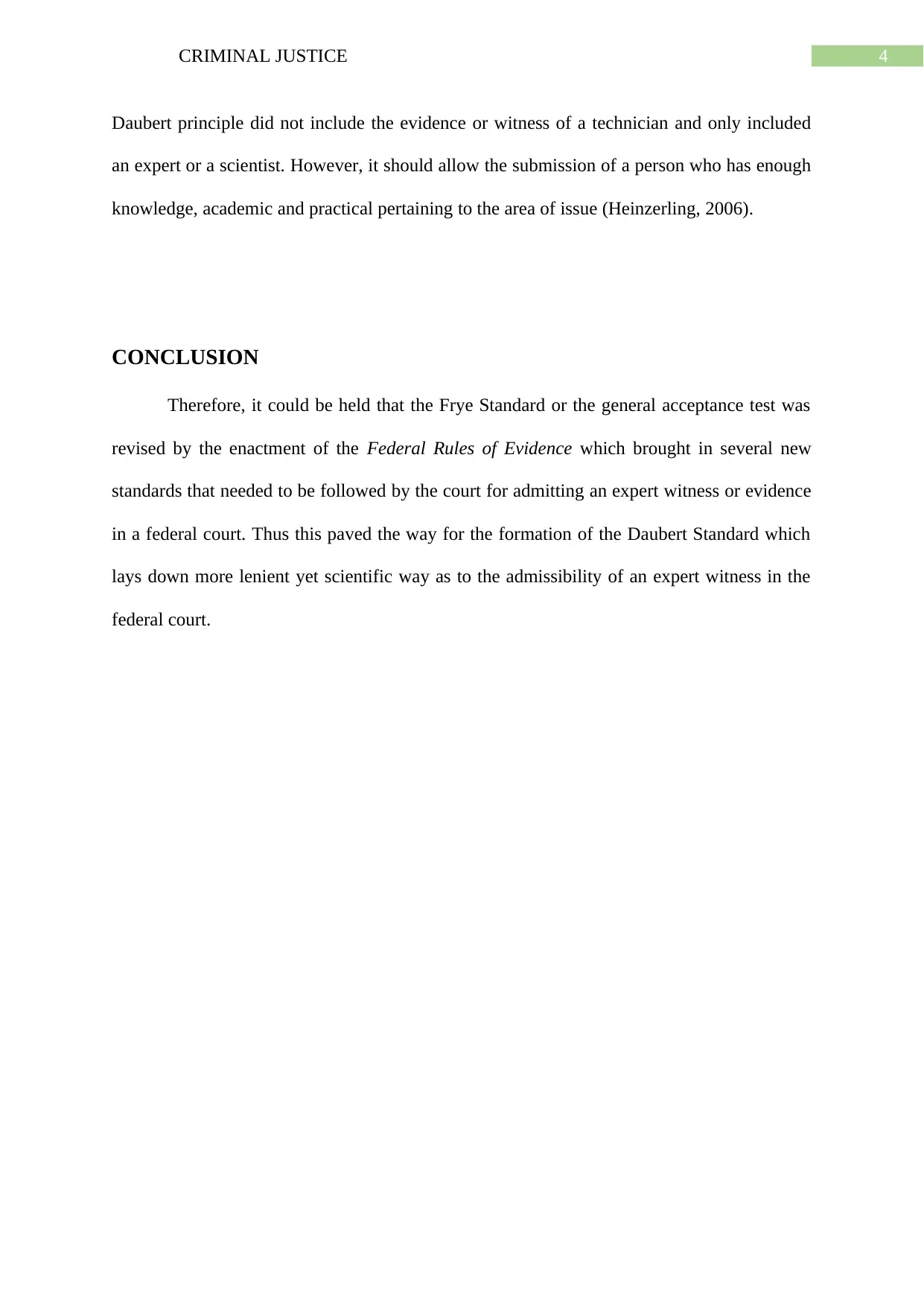
4CRIMINAL JUSTICE
Daubert principle did not include the evidence or witness of a technician and only included
an expert or a scientist. However, it should allow the submission of a person who has enough
knowledge, academic and practical pertaining to the area of issue (Heinzerling, 2006).
CONCLUSION
Therefore, it could be held that the Frye Standard or the general acceptance test was
revised by the enactment of the Federal Rules of Evidence which brought in several new
standards that needed to be followed by the court for admitting an expert witness or evidence
in a federal court. Thus this paved the way for the formation of the Daubert Standard which
lays down more lenient yet scientific way as to the admissibility of an expert witness in the
federal court.
Daubert principle did not include the evidence or witness of a technician and only included
an expert or a scientist. However, it should allow the submission of a person who has enough
knowledge, academic and practical pertaining to the area of issue (Heinzerling, 2006).
CONCLUSION
Therefore, it could be held that the Frye Standard or the general acceptance test was
revised by the enactment of the Federal Rules of Evidence which brought in several new
standards that needed to be followed by the court for admitting an expert witness or evidence
in a federal court. Thus this paved the way for the formation of the Daubert Standard which
lays down more lenient yet scientific way as to the admissibility of an expert witness in the
federal court.
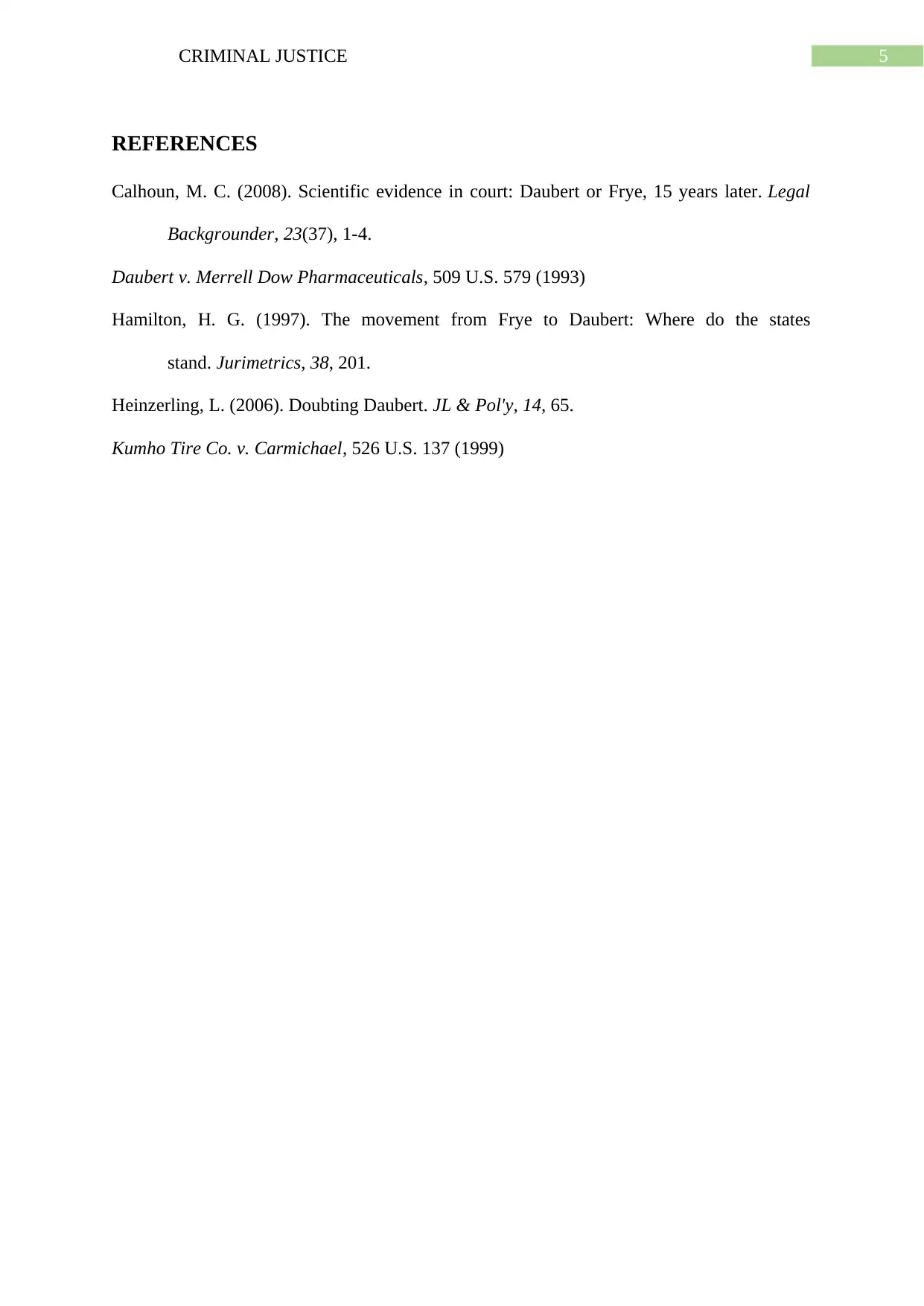
5CRIMINAL JUSTICE
REFERENCES
Calhoun, M. C. (2008). Scientific evidence in court: Daubert or Frye, 15 years later. Legal
Backgrounder, 23(37), 1-4.
Daubert v. Merrell Dow Pharmaceuticals, 509 U.S. 579 (1993)
Hamilton, H. G. (1997). The movement from Frye to Daubert: Where do the states
stand. Jurimetrics, 38, 201.
Heinzerling, L. (2006). Doubting Daubert. JL & Pol'y, 14, 65.
Kumho Tire Co. v. Carmichael, 526 U.S. 137 (1999)
REFERENCES
Calhoun, M. C. (2008). Scientific evidence in court: Daubert or Frye, 15 years later. Legal
Backgrounder, 23(37), 1-4.
Daubert v. Merrell Dow Pharmaceuticals, 509 U.S. 579 (1993)
Hamilton, H. G. (1997). The movement from Frye to Daubert: Where do the states
stand. Jurimetrics, 38, 201.
Heinzerling, L. (2006). Doubting Daubert. JL & Pol'y, 14, 65.
Kumho Tire Co. v. Carmichael, 526 U.S. 137 (1999)
⊘ This is a preview!⊘
Do you want full access?
Subscribe today to unlock all pages.

Trusted by 1+ million students worldwide
1 out of 6
Your All-in-One AI-Powered Toolkit for Academic Success.
+13062052269
info@desklib.com
Available 24*7 on WhatsApp / Email
![[object Object]](/_next/static/media/star-bottom.7253800d.svg)
Unlock your academic potential
Copyright © 2020–2025 A2Z Services. All Rights Reserved. Developed and managed by ZUCOL.
